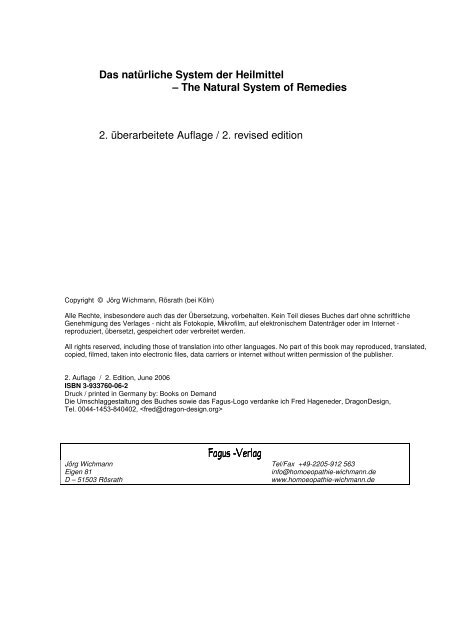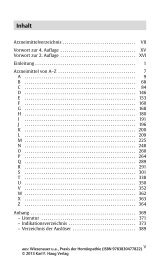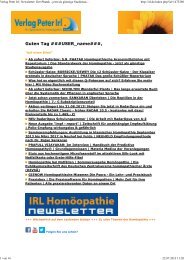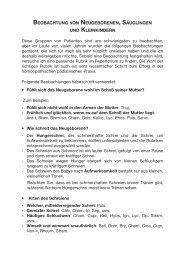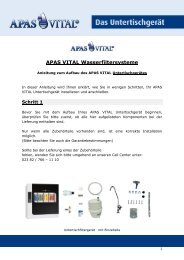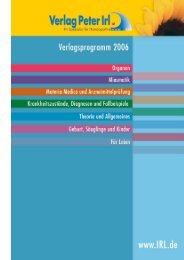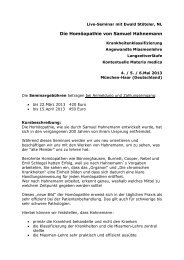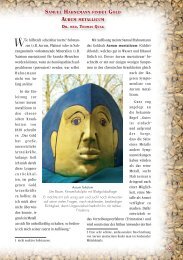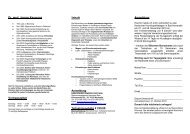Leseprobe (PDF) - Verlag Peter Irl
Leseprobe (PDF) - Verlag Peter Irl
Leseprobe (PDF) - Verlag Peter Irl
Sie wollen auch ein ePaper? Erhöhen Sie die Reichweite Ihrer Titel.
YUMPU macht aus Druck-PDFs automatisch weboptimierte ePaper, die Google liebt.
Das natürliche System der Heilmittel<br />
– The Natural System of Remedies<br />
2. überarbeitete Auflage / 2. revised edition<br />
Copyright © Jörg Wichmann, Rösrath (bei Köln)<br />
Alle Rechte, insbesondere auch das der Übersetzung, vorbehalten. Kein Teil dieses Buches darf ohne schriftliche<br />
Genehmigung des <strong>Verlag</strong>es - nicht als Fotokopie, Mikrofilm, auf elektronischem Datenträger oder im Internet -<br />
reproduziert, übersetzt, gespeichert oder verbreitet werden.<br />
All rights reserved, including those of translation into other languages. No part of this book may reproduced, translated,<br />
copied, filmed, taken into electronic files, data carriers or internet without written permission of the publisher.<br />
2. Auflage / 2. Edition, June 2006<br />
ISBN 3-933760-06-2<br />
Druck / printed in Germany by: Books on Demand<br />
!" # $ %& ' (<br />
Jörg Wichmann Tel/Fax +49-2205-912 563<br />
Eigen 81 info@homoeopathie-wichmann.de<br />
D – 51503 Rösrath www.homoeopathie-wichmann.de
2<br />
Das natürliche System der Heilmittel<br />
– The Natural System of Remedies<br />
2. überarbeitete Auflage / 2. revised edition<br />
Angelika Bolte, Jörg Wichmann<br />
„Es dürfen zu solchen Versuchen - denn von ihnen hängt die Gewißheit der ganzen Heilkunst und das Wohl aller<br />
folgenden Menschen-Generationen ab - es dürfen, sage ich, zu solchen Versuchen keine andern Arzneien, als solche<br />
genommen werden, die man genau kennt, und von deren Reinheit, Echtheit und Vollkräftigkeit man völlig überzeugt ist.“<br />
Hahnemann, Organon § 122<br />
„In these experiments - as the certainty of the whole art of healing, and the wellfare of all future generations of mankind<br />
depends on them - in these experiments, I say, no other medicines should be employed except such that are perfectly<br />
well known, and of whose purity, genuineness and full effectiveness we are thoroughly assured.“<br />
Hahnemann, Organon § 122
Vorwort zur Neuausgabe<br />
Acht Jahre nach dem ersten Erscheinen dieses Buches (als „Natürliche Verwandtschaft der Heilmittel“) ist die Arbeit mit<br />
Familiensystemen in der modernen Homöopathie üblich geworden und eines der wichtigsten Forschungsgebiete. Somit<br />
ist die genaue Aufstellung der wissenschaftlichen Ordnungssysteme der homöopathischen Heilmittel zwar<br />
überholungsbedürftig, aber so gefragt und wichtig wie immer. Immer mehr TherapeutInnen und LehrerInnen verwenden<br />
die Familienordnung der Pflanzen und Tiere und das Periodensystem als wesentliches Werkzeug zur Findung eines<br />
Arzneimittels.<br />
Die Neubearbeitung behält die Vorzüge der 1. Auflage bei:<br />
Vollständigkeit, Übersichtlichkeit, Dreisprachigkeit (Latein, Englisch, Deutsch),<br />
enthält aber außerdem:<br />
zahlreiche neue Mittel,<br />
verbesserte Familienordnungen nach neuen Erkenntnissen,<br />
Hinweise auf Arzneimittelprüfungen,<br />
Übersichtskarten des Pflanzen-, Tier und Periodensystems<br />
Deshalb ist das Werk umfangreicher und etwas teurer geworden. Die jeweils aktuellsten Eintragungen finden Sie auf<br />
unserer Website www.homoeopathie-wichmann.de.<br />
Vorwort<br />
Seit wir die Homöopathie und ihre Arzneimittellehren kennengelernt haben, ist es uns als seltsam aufgefallen, daß die<br />
Arzneimittel nach dem Alphabet geordnet werden und aus vielen dieser Materiae medicae nicht einmal erkennbar wird,<br />
um was für einen Stoff es sich dabei jeweils handelt.<br />
In den letzten paar Jahren hat sich unter Homöopathinnen und Homöopathen glücklicherweise ein Interesse auch<br />
an der Frage entwickelt, mit welcher Art Naturstoffen wir es überhaupt zu tun haben und wie diese miteinander verwandt<br />
sind. Da in der Natur - soweit wir es verstehen - nichts rein willkürlich ist, müssen wir davon ausgehen, daß mit<br />
fortschreitender Erfahrung auch unter den homöopathischen Mitteln eine gewisse Struktur zu erkennen sein wird, die<br />
sicher nicht unabhängig von den natürlichen Verwandtschaften der zugrunde liegenden Stoffe sein kann.<br />
Diese Ähnlichkeiten lassen sich aber nur systematisch beobachten, wenn uns das natürliche Ordnungssystem der<br />
Tiere, Pflanzen und chemischen Stoffe bekannt ist. Dazu dient die alphabetische Anordnung offenbar nicht. Wir haben<br />
deshalb die Heilmittel gemäß ihrer heute gültigen naturwissenschaftlichen Ordnung eingeteilt. Wir möchten aber, um<br />
Mißverständnisse zu vermeiden, hier feststellen, daß wir nicht der Auffassung sind, eine homöopathische Systematik<br />
der Heilmittel und ihrer Verwandtschaft könne mit dieser naturwissenschaftlichen Anordnung einfach übereinstimmen.<br />
Aber als eine Art erste Arbeitsgrundlage zur weiteren Beobachtung führt dieses natürliche System weiter als ein<br />
alphabetisches.<br />
In der folgenden Übersicht finden Sie alle homöopathischen Heilmittel, die in den gängigen Werken von<br />
Hahnemann, Kent, Allen, Clarke, Hering, Boericke, Mezger und auch in zusammenfassenden Handbüchern von Phatak,<br />
Vermeulen, Murphy erwähnt werden. Außerdem sind die meisten in der Phytotherapie gängigen Pflanzen zugeordnet<br />
sowie die von Edward Bach verwendeten Blütenpflanzen. Wir haben versucht, die zunehmende Fülle der in jüngster<br />
Zeit geprüft und ungeprüft verwendeten neuen Mittel einzuarbeiten, wobei uns aber sicherlich einige Mittel entgangen<br />
sind und einige stofflich nicht sicher identifizierbar blieben.<br />
In diese Arbeit haben sich trotz aller Mühe, sie zu vermeiden, sicherlich Fehler und Unvollständigkeiten eingeschlichen,<br />
für deren Korrekturen wir dankbar sind, ebenso wie für alle weiteren Anregungen, Ergänzungen und Kritiken.<br />
Sie erreichen uns unter<br />
Jörg Wichmann Tel/Fax +49-2205-912 563<br />
Eigen 81 info@homoeopathie-wichmann.de<br />
D – 51503 Rösrath www.homoeopathie-wichmann.de<br />
Für wichtige sachliche Hinweise danken wir Apothekerin Brita Gudjons; Kathleen A. Kron, Leiterin der Systematischen<br />
Sektion der Botanischen Gesellschaft Amerikas; Jeremy Sherr, Massimo Mangialavori, Magister Robert Müntz von der<br />
Remedia Apotheke, und vielen anderen, die nicht alle genannt werden können.<br />
3
Preface of the new edition<br />
Eight years after the first publication of this book (as „Natural Relationships of Remedies“) the work with these family<br />
systems has become popular in modern homeopathy and is one of its foremost areas of research. So the exact<br />
constellation of the scientific orders of homeopathic remedies is to always be renewed, but is as necessary as ever.<br />
More and more therapists and teachers use the families of plants and animals and the periodic system as an important<br />
tool to find their remedies.<br />
The new edition has kept the advantages of the 1st edition:<br />
completeness, clarity, three languages (Latin, English, German),<br />
and also includes:<br />
many new remedies,<br />
improved systematics after new researches<br />
mentioning of provings<br />
schemes of plant-, animal- and periodic system<br />
Therefore the book has become larger and more expensive.<br />
The latest entries you always find on our website: www.homoeopathie-wichmann.de.<br />
Preface<br />
Since we learned to know homeopathy and its materiae medicae, it seemed strange to us, that the remedies are always<br />
put into alphabetical order and that often it is not even recognizable what kind of substance it really is, that we are using.<br />
During the last few years fortunately the question which natural substances we are dealing with and how they are<br />
related towards each other, has found more interest among those working with homeopathy. As in nature - as far as we<br />
understand it - there is nothing arbitrary, we have to suppose that with the further developement of our knowledge there<br />
will be a certain kind of structure to be found amongst homeopathic remedies, which will not be independent of the<br />
natural relationship among the substances as such.<br />
We will only be able to systematically observe these similarities between different remedies as long as the natural<br />
order of relationships among animals, plants and chemical substances is known to us. The alphabetical order obviously<br />
does not encourage this. For this reason we have put the remedies into their modern scientific order. To avoid<br />
misunderstandings we wish to state clearly that we are not of the opinion that an homeopathic system of remedies and<br />
their relationship could be simply identical with this scientific order. But as a kind of working basis for further studies and<br />
observations the natural system will help us more than an alphabetical one.<br />
In the following book you will find all homeopathic remedies mentioned in the common works of Hahnemann, Kent,<br />
Allen, Clarke, Hering, Boericke, Mezger and also in the more summarizing materiae medicae of Phatak, Vermeulen,<br />
Murphy. Besides this we have added most of the plants generally used in herbalism as well as the plants used by<br />
Edward Bach. We have tried to include the fast increasing number of proved or unproved new remedies, but certainly<br />
missed some of them.<br />
Despite all our efforts there will be several mistakes and incompletenesses. And we are grateful for any corrections,<br />
suggestions, additions and criticism.<br />
Please get in touch with us by<br />
Joerg Wichmann Phone/Fax +49-2205-912 563<br />
Eigen 81 info@homoeopathie-wichmann.de<br />
D – 51503 Roesrath www.homoeopathie-wichmann.de<br />
For important advice on the subject we thank pharmacist Brita Gudjons; Kathleen A. Kron, Chairperson of Systematic<br />
Section of the Botanical Society of America; Jeremy Sherr; Massimo Mangialavori; Magister Robert Müntz of Remedia<br />
Pharmacy, as well as many others that cannot all be mentioned.<br />
4
KINGDOMS - NATURREICHE - REGNA<br />
animate kingdoms – belebte Naturreiche:<br />
Eukaryotae:<br />
Animalia – Animals – Tiere 7<br />
Plantae – Plants – Pflanzen 30<br />
Fungi – Pilze 82<br />
Protista – Protists – Protisten 85<br />
Procaryotae:<br />
Monera – Bacteria – Bakterien 86<br />
inanimate kingdoms – unbelebte Naturreiche:<br />
Viri – Viruses – Viren 90<br />
Mineralia – Minerals – Minerale 92<br />
Fields of Energy – Energiefelder<br />
– Imponderabilia 112<br />
5
6<br />
ANIMALIA – ANIMALS – TIERE<br />
Among the phyla (clades) of the animal kingdom are:<br />
Zu den Stämmen des Tierreichs gehören folgende:<br />
Porifera – Schwämme – Sponges 8<br />
Coelenterata – Hohltiere/ Cnidaria – Nesseltiere 8<br />
Annelida – Ringel-,Gliederwürmer – Jointed Worms 9<br />
Echinodermata – Stachelhäuter – Echinoderms 9<br />
Mollusca – Weichtiere – Molluscs 10<br />
Arthropoda – Gliederfüsser – Arthropodes 12<br />
a) Chelicerata – Scherenfüsser, Fühlerlose<br />
b) Diantennata<br />
c) Tracheata – Tracheentiere – Tracheates<br />
d) Trilobita – Trilobiten<br />
Chordata<br />
a) Tunicata – Manteltiere<br />
b) Acrania – Schädellose<br />
c) Vertebrata – Wirbeltiere – Vertebrates 18
Porifera - Schwämme - Sponges<br />
Calcarea - Kalkschwämme<br />
Demospongiae - Gemeinschwämme<br />
Cornaeuspongida – Netzfaserschwämme<br />
Spongiidae<br />
Euspongia officinalis/<br />
Spongia tosta<br />
Spongillidae - Süsswasserschwämme<br />
Meeresschwamm Roasted<br />
Sponge<br />
Spongilla lacustris/ Badiaga Flußschwamm Freshwater Sponge<br />
Spongia off.,<br />
dt.: Dalmatiner Schwamm<br />
Sp. fluviatilis<br />
Coelenterata - Hohltiere/ Cnidaria - Nesseltiere<br />
Hydrozoa<br />
Siphonophora - Staatsquallen<br />
Physaliidae - Seeblasen<br />
Physalia physalis Portugiesische<br />
Galeere<br />
Portuguese-<br />
Man-of-War<br />
Scyphozoa - Echte Quallen - Jellyfish<br />
Semaeostoma - Fahnenquallen<br />
Ulmariidae<br />
Aurelia aurita / Medusa Ohrenqualle Jellyfish<br />
Anthozoa - Korallentiere - Corals<br />
Gorgonaria - Rindenkorallen<br />
Corallium nigrum Schwarze Koralle Black Coral<br />
Corallium rubrum Rote Koralle Red Coral<br />
Physalia pelagica, utricularia<br />
dt.: Seeblase, engl.: Blue-bottle<br />
dt.: Lappenqualle, engl.: Sea-nettle<br />
Gorgonio nobilis, dt.: Blutkoralle,<br />
Edelkoralle, engl.: Red Precious Coral<br />
*Spong<br />
*Bad<br />
*Physala-p<br />
*Medus<br />
*Cor-n<br />
*Cor-r<br />
7
Annelida<br />
– Ringel-,Gliederwürmer – Jointed Worms<br />
Clitellata – Gürtelwürmer Class<br />
Oligochaeta – Wenigborster Order<br />
8<br />
Terricolae – Regenwürmer Family<br />
Helodrilus caliginosus Regenwurm Common Field Worm<br />
Hirudinea – Egel<br />
Hirudinidae<br />
Hirudo medicinalis Medizinischer Blutegel Leech<br />
Polychaeta – Vielborster<br />
Arenicolidae<br />
Arenicola marina Wattwurm Lugworm<br />
Garden Worm<br />
Prov:lk<br />
Sanguisuga officinalis<br />
Pierwurm<br />
Prov.: jt<br />
Echinodermata<br />
– Stachelhäuter – Echinoderms<br />
Holothurioidea – Seegurken – Sea Cucumbers<br />
Echinoidea – Seeigel – Sea Urchins<br />
Diadematioda<br />
Toxopneustidae<br />
Toxopneustes pileolus Giftzangen-Seeigel flower sea urchin<br />
Pha:r / Prov:jh<br />
Asteroidea - Seesterne – Starfish Class<br />
Forcipulatida – Zangensterne Order<br />
Asteriidae Family<br />
Asterias rubens Gemeiner Seestern Red Starfish<br />
Asteriacanthion r., engl.: Sea Star<br />
Valvatida – Klappensterne<br />
Acanthasteridae<br />
Acanthaster planci Dornenkronenseestern<br />
Crown-of-thorns<br />
starfish<br />
Pha:r / Prov:jh<br />
*Helod-c<br />
*Hir<br />
*Areni-m<br />
*Toxop-pi<br />
*Aster<br />
*Acan-pl
Mollusca – Weichtiere – Molluscs<br />
Gastropoda - Schnecken – Snails Class<br />
Opisthibranchia – Hinterkiemer Subclass<br />
Prosobranchia – Vorderkiemer<br />
Mesogastropoda – Mittelschnecken Order<br />
Cypraeidae – Kaurimuscheln Family<br />
Neogastropoda – Neuschnecken<br />
Muricidae – Stachelschnecken / Leistenschnecken<br />
Pulmonata – Lungenschnecken<br />
Stylommatomorpha – Landlungenschnecken<br />
Helicidae – Weinbergschneckenartige<br />
Bivalvia – Muscheln – Mussels Class<br />
Eulamellibranchiata Order<br />
(umfaßt die meisten bekannten Meeres- u. Süßwassermuscheln<br />
/ includes most sea- and sweetwater mussels)<br />
Anisomyaria Order<br />
Ostreidae – Austern – Oysters Family<br />
Pectinidae – Kammuscheln<br />
Cephalopoda – Kopffüsser – Cephalopods<br />
Tetrabranchiata – Vierkiemer<br />
Nautilidae<br />
Decabrachia - Zehnarmige<br />
Sepioidea – Tintenschnecken – Cuttlefish<br />
Sepiidae – Tintenschnecken<br />
Teuthoidea – Kalmare – Squids<br />
Loliginidae<br />
Onychoteuthidae – Hakenkalmare<br />
Octobrachia – Kraken – Octopus<br />
Octopodidae – Kraken<br />
9
Gastropoda - Schnecken – Snails<br />
10<br />
Cypraeidae – Kaurimuscheln<br />
Cypraea eglantina /<br />
Kauri<br />
Kaurischnecke Cowrie Snail<br />
Muricidae – Stachelschnecken / Leistenschnecken<br />
Murex spec. / Murex purpurea Purpurschnecke Purple Fish<br />
C. nigricans, C. niger, C. luctosa, C. couturieri, C.<br />
perconfusa, C. momokiti; dt.: Porzellanschnecke,<br />
engl.: Cowry Abbr.: Kauri Prov:as<br />
*Cypra-e<br />
Die geprüfte Species ist zoologisch nicht mehr identifizierbar, in Frage kommen die Schnecken Murex brandaris, M. trunculus oder<br />
Purpura lapillus. / The proved species is not identifyable any more. Possible are Murex brandaris, M. trunculus oder Purpura lapillus.<br />
Helicidae – Weinbergschneckenartige<br />
Helix spec./ H.tosta Geröstete<br />
Weinbergschnecke<br />
Bivalvia – Muscheln – Mussels<br />
Ostreidae – Austern – Oysters<br />
Ostrea edulis/ Calcium<br />
carbonicum<br />
Austernschalen-<br />
Kalk<br />
Toasted Edible<br />
Snail<br />
Lime from<br />
Oystershells<br />
Conchiolinum Perlmutt Mother of Pearl<br />
Pectinidae – Kammuscheln<br />
Pecten jacobaeus Jakobsmuschel Scallop<br />
Venus mercenaria Venusmuschel American<br />
Scallop<br />
Cephalopoda – Kopffüsser – Cephalopods<br />
Nautilidae<br />
Nautilus spec. Perlboot Nautilus<br />
Sepiidae – Tintenschnecken<br />
Sepia officinalis Tintenfischtinte Cuttlefish, Catfish<br />
Sepia gruneris<br />
nach Gruner, von unlöslichen<br />
Bestandteilen befreite<br />
Dilution der S.tinte<br />
Helix pomatia oder H.aspersus, Abbr.:<br />
Helix<br />
Calcarea carbonica, Calcarea ostrearum,<br />
Conchae<br />
Mater perlarum<br />
Kammuschel<br />
Mercenaria m.<br />
dt. Schiffsboot<br />
Prov:gr<br />
preparation after Gruner where all<br />
unsolulable particles of the ink of<br />
Sepia are filtrated<br />
Ossa sepiae Schulp Backbone of Sepia<br />
Loliginidae<br />
Loligo vulgaris Gemeiner Kalmar Kalamaris<br />
Onychoteuthidae – Hakenkalmare<br />
Onychotheutis banksii Gemeiner<br />
Krallenkalmar<br />
Octopodidae – Kraken<br />
Octopus vulgaris Gemeiner Krake Octopus<br />
Eledone cirrhosa Kleiner Krake Small Octopus<br />
Prov:gr<br />
Sepiae succus<br />
Tetronychoteutis Krohni<br />
Prov:gr<br />
Polypus oktopus<br />
E. cirrata, dt.: Zirrenkrake<br />
Prov:bp<br />
Sepiae off. purificata<br />
Pha:dhu<br />
*Murx<br />
*Helx<br />
*Calc<br />
*Conch<br />
*Pect<br />
*Ven-m<br />
*Naut<br />
*Sep<br />
*Sep-grun<br />
*Sep-os<br />
*Loli-v<br />
*Onych-b<br />
*Octo-v<br />
*Eled-c


